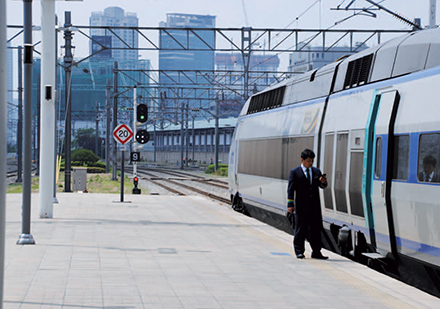|
South Korea’s Sudokwon high-speed line, the third
high-speed rail line in the country, entered revenue service on 2 December
2016. The line includes three stations, is 38-mile long, and connects to the
existing SeoulBusan high-speed line. Almost 32 mi of the new line is in a
tunnel. Alstom, as part of a consortium led by LSIS, was awarded the contract
by Korea Rail Network Authority in December 2014. This project is executed
by Alstom Transport S.A. (France) with support from Alstom U.K., Alstom
Belgium, and Alstom Korea.

Alstom has been in South Korea for transport activities
for more than 40 years. The group has supplied locomotives, high-speed
integrated systems to equip the KTX Seoul-Busan line with 46 high-speed
trains, core system engineering, and catenary and traffic control system
manufacturing.
The KTX Seoul-Busan line has a total of ten stations,
opened in two phases. The Seoul-Daegu line started revenue service in
2004, and the Daegu-Busan line has been in operation since 2010.
Korail-subsidiary Supreme Railways launched commercial services on the
Suseo high-speed line on 9 December 2016, providing a much-needed rail
link for the southeastern areas of Seoul and Gyeonggi province under the
super-rapid-train (SRT) brand.
Previously, residents in these areas have had to spend
extra time traveling north to Seoul or Yongsan stations to use high-speed
services. The terminus, Suseo station, is also located much closer to one
of South Korea’s main business districts.
The new line has three stations—Suseo (Seoul),
Dongtan (Hwaseong City), and Jije (Pyeongtaek City)—with the
remainder of the route connecting to the main high-speed line used by
Korail’s KTX services. SRT services do not travel to all parts of
the high-speed network, and passengers will need to transfer to KTX
services to access some stations.
The fastest services to Busan and Mokpo offer journey
times of 2 h, 9 min and 2 h, 6 min, respectively. SRT fares are also 10%
lower than the KTX equivalent. To compete with the new service, Korail is
now offering discounts and a rewards system.
Construction began in 2011, and the new line was
completed in June 2015. The main engineering feature of the new line is
the 3-mile Yulhyeon Tunnel, the longest railway tunnel in South Korea.
Dongtan station is also South Korea’s first high-speed station to
have been built completely underground, with platforms located six
stories below street level.
Only 7% of the 38-mi line runs on a surface alignment.
SRT services use KTX-Sancheon trains produced by Hyundai Rotem, with the
fleet consisting of ten new trains and 22 trains leased from Korail. Over
the past decade, patronage of KTX services has continued to grow and
tickets often sell out on weekends. The opening of the SRT boosts the
total number of high-speed weekend services operating in South Korea by
43% from 269 to 384.
Full article: IEEE Vehicular Technology Magazine, Volume 12, Number 2, June 2017 |